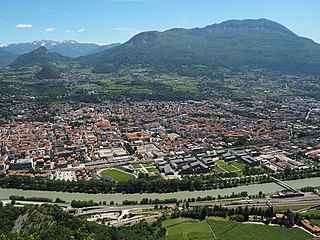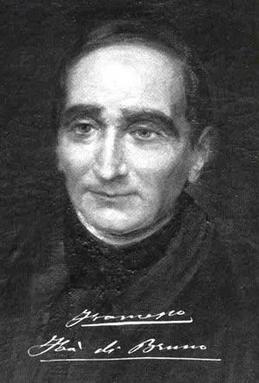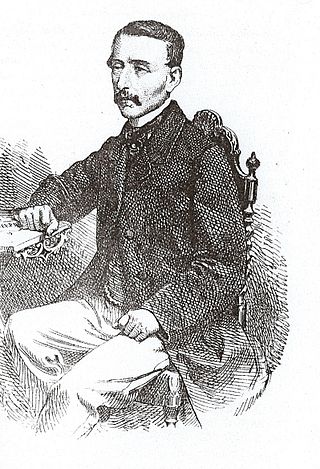
Giosuè Alessandro Giuseppe Carducci was an Italian poet, writer, literary critic and teacher. He was noticeably influential, and was regarded as the official national poet of modern Italy. In 1906, he became the first Italian to receive the Nobel Prize in Literature. The Swedish Academy awarded him the prize "not only in consideration of his deep learning and critical research, but above all as a tribute to the creative energy, freshness of style, and lyrical force which characterize his poetic masterpieces."

Trento, also known in English as Trent, is a city on the Adige River in Trentino-Alto Adige/Südtirol in Italy. It is the capital of the autonomous province of Trento. In the 16th century, the city was the location of the Council of Trent. Formerly part of Austria and Austria-Hungary, it was annexed by Italy in 1919. With 118,142 inhabitants, Trento is the third largest Italian city in the Alps and second largest in the historical region of Tyrol.

Francesco Faà di Bruno was an Italian priest and advocate of the poor, a leading mathematician of his era and a noted religious musician. In 1988 he was beatified by Pope John Paul II. He is the eponym of Faà di Bruno's formula.

The University of Trento is an Italian university located in Trento and nearby Rovereto. It has been able to achieve considerable results in didactics, research, and international relations according to CENSIS and the Italian Ministry of Education.
Mario Liverani, is an Italian historian and Professor of Ancient Near East History at the University of Rome La Sapienza. He is a member of many institutions, such as the American Oriental Society, Accademia delle Scienze di Torino, and doctor Honoris Causa of the University of Copenhagen and the Autonomous University of Madrid.

Jeffrey Schnapp is an American university professor who works as a cultural historian, designer, and technologist. Until joining the Harvard University in 2011, he was the director of the Stanford Humanities Lab from its foundation in 1999 through 2009. At Harvard, he holds the Carl Pescosolido Chair in Romance and Comparative Literatures in the Faculty of Arts and Sciences and also teaches in the Department of Architecture at Harvard's Graduate School of Design. Effective June 2015, he assumed the position of Chief Executive Officer and co-founder of Piaggio Fast Forward, the robotics division of the Piaggio. In 2018 he transitioned to the role of Chief Visionary Officer, handing over the role of CEO to his co-founder Greg Lynn. In October 2021, Piaggio Fast Forward launched a second product, gita mini.

Giacomo Bresadola 14 February 1847 – Trento 9 June 1929) was an eminent Italian mycologist. Fungi he named include the deadly Lepiota helveola and Inocybe patouillardii, though the latter is now known as Inosperma erubescens as this latter description predated Bresadola's by a year. He was a founding member of the Société mycologique de France.
Giovanni (de) Cobelli was an Italian civil servant and amateur naturalist.
Kaspar Anton von Baroni-Cavalcabo or Gaspare Antonio Cavalcabò Baroni was an Italian painter in a late Baroque period and style. During the greater part of his life he lived in Sacco, where he died. Many of his drawings are in the Library at Innsbruck.

Carlo Ilarione Petitti count of Roreto was an Italian economist, academic, writer, counsellor of state, and senator of the Kingdom of Sardinia. He is seen as a prominent figure in the Italian Risorgimento.

Allessandro Parronchi was an Italian poet, art historian, and literary critic. He won the 1999 Mondello Prize for literature.

Giovanni Battista Traverso (1878–1959) was a mycologist and plant pathologist on the early 20th-century.

The Church of Santa Maria Maggiore is an important place of worship in the city of Trento, and the site of the Third Session of the Council of Trent. It was built by Antonio Medaglia on the model of the basilica of Sant'Andrea in Mantua, at the wish of the Prince-Archbishop Bernardo Clesio. In November 1973 Pope Paul VI accorded it the status of minor cathedral.
The following is a timeline of the history of the city of Trento in the Trentino-South Tyrol region of Italy.

The Rotzo Formation is a geological formation in Italy, dating to roughly between 192 and 186 million years ago and covering the Pliensbachian stage of the Jurassic Period in the Mesozoic Era. Has been traditionally classified as a Sinemurian-Pliensbachian Formation, but a large and detailed dataset of isotopic 13C and 87Sr/86Sr data, estimated the Rotzo Formation to span only over the Early Pliensbachian, bracketed between the Jamesoni-Davoei biozones, marked in the Loppio Oolitic Limestone–Rotzo Fm contact by a carbon isotope excursion onset similar to the Sinemu-Pliens boundary event, while the other sequences fit with the a warm phase that lasts until the Davoei biozone. The Rotzo Formation represented the Carbonate Platform, being located over the Trento Platform and surrounded by the Massone Oolite, the Fanes Piccola Encrinite, the Lombadian Basin Medolo Group and Belluno Basin Soverzene Formation, and finally towards the south, deep water deposits of the Adriatic Basin. The Pliensbachian Podpeč Limestone of Slovenia, the Aganane Formation & the Calcaires du Bou Dahar of Morocco represent regional equivalents, both in deposition and faunal content.

Francesco Salata was a Dalmatian Italian senator, politician, journalist, historian and writer. Salata was an irredentist, although he had a more legalistic approach than other contemporaries, as well as being more liberal. He was panned and attacked by the fascists, although, after they took power, he was employed by the fascist government, and wrote books apologizing for the fascist politics. Very fond of his native Istria, Salata opposed what he saw as the slavicisation carried out by Croatian priests in Istria, the Kvarner and Dalmatia. He accused the Slovenian and Croatian clergy of carrying out the slavicisation of Istria and the Kvarner. Salata upheld the idea that Dalmatia, Istria and the Kvarner were, historically, Italian lands.

Bonaventura Corti was an Italian Jesuit priest and naturalist who contributed to studies on microscopic organisms including the rotifers, ciliates and algae. He coined the word "plantanimal" for plant-like organisms which moved and which could be revived from desiccation through the addition of water.

Emilio Villari was an Italian experimental physicist and a professor at the University of Bologna and later Naples who contributed to studies on electromagnetism after whom is named the Villari Effect which is used in devices used to measure mechanical stress and strain. He also developed a quadrant electrometer.

The Fortress of Trento is the fortified wall built around the city of Trento starting in 1860 and strategically active until its dissolution in 1916.
Giovanni Baschenis (1471–1503) was an Italian painter whose name is combined with that of his brother Battista, also a painter.















